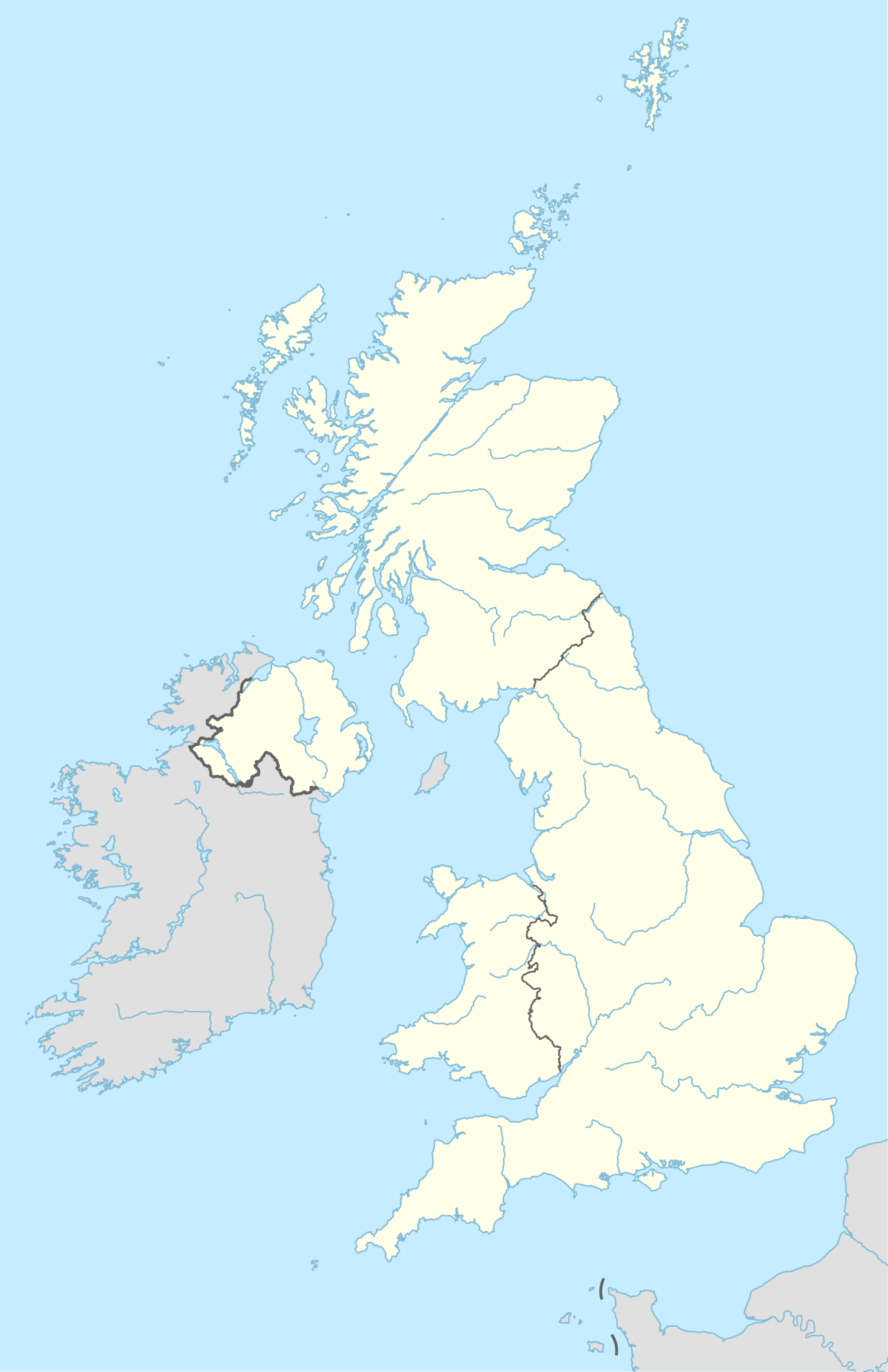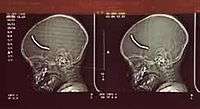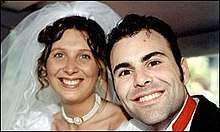1999 London nail bombings
| 1999 London bombings | |
|---|---|
 Brixton Brick Lane Soho 1999 London nail bombings (Greater London)  Brick Lane Soho 1999 London nail bombings (the United Kingdom) | |
| Location | London, England |
| Date |
17 April 1999- 30 April 1999 |
| Target | Black British, British Bengali and Gay populations |
Attack type | White supremacist terrorism, bombings, murder |
| Weapons | Nail bomb |
| Deaths | 3 |
Non-fatal injuries | 140 |
| Perpetrators | David Copeland |
| Motive | attempt at starting a race war in England |
The 1999 London nail bombings were a series of bomb explosions in London, England. Over three successive weekends between 17 and 30 April 1999, homemade nail bombs were detonated respectively in Brixton, south London; Brick Lane in the East End; and in The Admiral Duncan pub in Soho in the West End. Each bomb contained up to 1,500 four-inch nails, in holdalls that were left in public spaces. The bombs killed three people, including a pregnant woman, and injured 140 people, four of whom lost limbs.
On 2 May 1999, the Metropolitan Police Anti-Terrorist Branch charged 22-year-old David Copeland with murder. Copeland, who became known as the "London Nail Bomber", was a Neo-Nazi militant and a former member of two far-right political groups, the British National Party and then the National Socialist Movement. The bombings were aimed at London's Black, South Asian and gay communities.[1] He was convicted of murder in 2000 and given six concurrent life sentences.[1]
Overview
Brixton Market bomb

The first bombing, on Saturday, 17 April 1999, was in Electric Avenue, Brixton; an area of south London with a large black population. The bomb was made using explosives from fireworks, taped inside a sports bag, primed and left at Brixton Market. The Brixton Market traders became suspicious, and one of them, Gary Shilling, moved the bag to a less crowded area after seeing perpetrator Copeland acting suspiciously. Two further moves of the bomb occurred by unconvinced traders, including the bomb being removed from the bag, which is when it ended up by the Iceland supermarket. Concerned traders called the police, who arrived at the scene just as the bomb detonated at 5:25 pm. Forty-eight people were injured, many of them seriously because of the four-inch nails that were packed around the bomb. The explosion was strong, sending nails in all directions, blowing windows and blasting a parked car across the street.[2]
Brick Lane bomb
The second bomb, on the following Saturday, 24 April, was aimed at Brick Lane in the East End of London, which has a large Bangladeshi community. There is a street market on Sundays, but perpetrator Copeland mistakenly tried to plant the bomb on Saturday when the street was less busy. Unwilling to change the timer on the bomb, he left it instead in a black Reebok bag on Hanbury Street. There it was picked up by a man, who brought it to the police station on Brick Lane, which was shut. He had placed it in the boot of his Ford Sierra car which was parked outside number 42 Brick Lane, where it exploded.[3] Thirteen people were injured, and surrounding buildings and cars were severely damaged. At the time, Muslims were gathering outside the East London Mosque for prayers.[4]
Admiral Duncan bomb
The third and final bomb was planted and detonated on the evening of Friday, 30 April at The Admiral Duncan pub on Old Compton Street in Soho, the heart of London's gay community. At the time the pub and the street outside were crowded because the evening was the start of a Bank Holiday weekend. The unattended sports bag containing the bomb, which was taped inside, was noticed by patrons of the Admiral Duncan; however, the bomb exploded at 6:37 pm just as the bag was being investigated by the pub manager, Mark Taylor.[5] Three people were killed and a total of seventy-nine were injured, many of them seriously. Four of the survivors had to have limbs amputated.[6]
Victims

| Casualties (deaths) | |
|---|---|
| Brixton | 48 (0) |
| Brick Lane | 13 (0) |
| Soho | 79 (3) |
At the gay pub bombing in Soho, Andrea Dykes, 27, four months pregnant with her first child, died along with her friends and hosts for the evening, Nick Moore, 31, and John Light, 32, who was to be the baby's godfather. Andrea's husband, Julian, who married in August 1997, was seriously injured. The four friends from Essex had met up in the Admiral Duncan to celebrate Andrea's pregnancy.[7]
Investigation and arrest
Following the Brixton bombing, officials initially emphasised that IRA involvement was unlikely and that it was more likely to be the work of right-wing terrorists following the Stephen Lawrence Inquiry that was released at the time, or a 'copycat' Edgar Pearce. On 19 April, Combat 18, a far-right organisation, claimed responsibility via telephone.[8] By the time of the Brick Lane bombing a week later, which the police linked with the Brixton bombing, it was clear that a racist entity was behind the attacks. It also ignited fears of racial tensions, particularly after the release of the Stephen Lawrence Inquiry in February, and as Brixton was the scene of race riots in 1981.[9]
Although these had been described by the police as specifically race-hate attacks, they had issued a warning that a gay bar could potentially be the bomber's next target, and The Yard – a pub in the Soho area – had displayed a poster warning customers to be alert.[5] On Thursday 29 April, CCTV footage from the Brixton attack was given wide publicity after an image of the suspected bomber was identified on it. This caused Copeland to bring forward his planned bombing of the Admiral Duncan to Friday evening. Paul Mifsud, a colleague of Copeland, recognised him from the footage and alerted the police about an hour and 20 minutes before the third bombing, at the Admiral Duncan pub.[10]
The Soho pub bombing was linked to the previous ones by police, with far-rightists once again the prime suspects. Two hours after the bomb, a person claiming to be from the putative far-right White Wolves organisation called the BBC, claiming the group's responsibility to the attack. It was feared Jews, Chinese and Irish would be targeted next. Some synagogues stepped up security as a result.[11]
Copeland was arrested that night once the police obtained his address, a rented room in Sunnybank Road, Cove, Hampshire. He admitted carrying out the three bombings as soon as he opened the door to the police, telling them, "Yeah, they were all down to me. I did them on my own." He showed them his room, where two Nazi flags were hanging on a wall, along with a collection of photographs and newspaper stories about bombs. [12]
David Copeland

David James Copeland was born on 15 May 1976, in Hanworth[12] in the London Borough of Hounslow,[13] to a working-class couple. His father was an engineer and his mother was a housewife. He lived for most of his childhood with his parents and two brothers in Yateley, Hampshire, attending Yateley School, where he obtained seven GCSEs before leaving in 1992. Journalist Nick Ryan wrote that, as a teenager, Copeland feared he was homosexual; when his parents sang along to The Flintstones theme on television—"we'll have a gay old time"—he reportedly believed they were sending him a message. As an older teenager, he began listening to heavy metal bands and earned himself the nickname "Mr Angry". Ryan wrote that the staff at his school have no recollection of him during this period. It was as if he had become invisible.[14]
After his arrest following the bombings, he told psychiatrists that he had started having sadistic dreams when he was about twelve years old, including dreams or fantasies that he had been reincarnated as an SS officer with access to women as slaves.[15] He left school for a series of failed jobs, reportedly blaming immigrants for the difficult job market. He became involved in petty crime, drinking, and drug abuse. His father was eventually able to get him a job as an engineer's assistant on the London Underground.[14]
His father called him "fairly intelligent" as a child. His parents separated when he was 19, and his mother told lawyers and psychiatrists after the arrest that he was a "happy lad" and showed no sign of what was to come. According to psychiatrists, Copeland also had a higher than average IQ.[16] One of the doctors believed his behaviour started to change around 1995 when he was 19, isolating himself from friends and family.[17]
Political views
Copeland joined the far-right British National Party in May 1997, at the age of twenty-one. He acted as a steward at a BNP meeting, in the course of which he came into contact with the BNP leadership and was photographed standing next to John Tyndall, the leader of the party at the time. It was during this period that Copeland read The Turner Diaries, and first learned how to make bombs using fireworks with alarm clocks as timers, after downloading a so-called “terrorist's handbook” from the internet. He left the BNP in 1998, regarding it as insufficiently hardline because it was not willing to engage in paramilitary action,[18] and joined the smaller National Socialist Movement, becoming its regional leader for Hampshire just weeks before the start of his bombing campaign. It was around this time that he visited his family doctor and was prescribed anti-depressants after telling the doctor he felt he was losing his mind.[12]
Motivation
Copeland maintained he had worked alone and had not discussed his plans with anyone. During police interviews, he admitted holding neo-Nazi views, and talked of his desire to spread fear and trigger a race war. He told police, "My main intent was to spread fear, resentment and hatred throughout this country; it was to cause a racial war." He said, "If you've read The Turner Diaries, you know the year 2000 there'll be the uprising and all that, racial violence on the streets. My aim was political. It was to cause a racial war in this country. There'd be a backlash from the ethnic minorities, then all the white people will go out and vote BNP."[19]
After his arrest, Copeland wrote to BBC correspondent Graeme McLagan, denying that he had schizophrenia, and telling McLagan that the "Zog" or Zionist Occupation Government was pumping him full of drugs in order to sweep him under the carpet. He wrote, "I bomb the blacks, Pakis, degenerates. I would have bombed the Jews as well if I'd got a chance." Ryan writes that Copeland's first idea had been to bomb the Notting Hill Carnival, after seeing images of the 1996 Atlanta Olympics bombing.[14] When asked by police why he had targeted ethnic minorities, he replied, "Because I don't like them, I want them out of this country, I believe in the master race."[20] Whilst on remand, Copeland also wrote to crime writer Bernard O'Mahoney, who posed as a woman called Patsy Scanlon in the hope of duping Copeland into confessing. According to The Independent, the letters helped secure a conviction by giving prosecutors evidence about Copeland's state of mind.[21]
Conviction
Copeland's mental state was assessed at Broadmoor Hospital. He was diagnosed by five psychiatrists as having paranoid schizophrenia, while one diagnosed a personality disorder not serious enough to avoid a charge of murder. There was no dispute that he was mentally ill, but the extent of this, and whether he was unable to take responsibility for his actions, became a matter of contention. At the Old Bailey, Copeland's plea of guilty to manslaughter on the grounds of diminished responsibility was not accepted by the prosecution or jury.[12]
He was convicted of three counts of murder and planting bombs on 30 June 2000, and given six concurrent life sentences.[1] The trial judge spoke of his doubt that it would ever be safe to release Copeland.[22]
On 2 March 2007, the High Court decided that he should remain in prison for at least 50 years, ruling out his release until 2049 at the earliest, when he would be 73.[18] Copeland appealed; on 28 June 2011, the Court of Appeal upheld the ruling.[23]
Further conviction
In June 2014, Copeland attacked a fellow inmate at HM Prison Belmarsh with a shiv, an improvised weapon made from razor blades attached to a toothbrush handle. In October 2015, he pleaded guilty to wounding with intent and was sentenced to a further three years in prison, of which he will serve 18 months.[24]
See also
- Combat 18
- Tony Lecomber
- David Myatt
- The First Domino, a 2009 play written by one victim of the Soho bomb[25]
- Homophobia
- White supremacy
- Xenophobia
References
- 1 2 3 Buncombe, Andrew; Judd, Terri; and Bennett, Jason. "'Hate-filled' nailbomber is jailed for life", The Independent, 30 June 2000.
- ↑ Thompson, Tony; Honigsbaum, Mark; and Ridley, Yvonne. "Nail bomb injures 48 in Brixton blast", The Guardian, 18 April 1999.
- Carroll, Rory and Woodward, Will. "Bomb survivors tell of bloody chaos", The Guardian, 19 April 1999.
- For the image of the baby, see "The London nail bombs", The Guardian, accessed 2 March 2011.
- ↑ Sengupta, Kim; Gregoriadis, Linus; Mullins, Andrew (26 April 1999). "East London Bombing: `We knew Brick Lane would be next, but thought it wouldn't be so quick'". The Independent. Retrieved 3 December 2014.
- ↑ "Car bomb explodes in London's Brick Lane", Press Association, 24 April 1999.
- Millar, Stuart. 'We're at war and if that means more bombs, so be it...', The Guardian, 27 April 1999.
- Millar, Stuart. "Anti-terror police seek White Wolf racist over bombs", The Guardian, 28 April 1999.
- 1 2 Simon Edge. "Look Back in Anger". Gay Times. Archived from the original on 28 September 2011. Retrieved 30 July 2011.
- ↑ "Nail bomb explosion at London pub kills two", The Guardian, 30 April 1999.
- By Honigsbaum, Mark; Campbell, Denis; Thompson, Tony; Ryle, Sarah; Veash, Nicole; and Wazir, Burhan. "Bomb factory man seized as death toll rises", The Guardian, 2 May 1999.
- "Gay community hit by nail bomb", The Guardian, 5 May 1999.
- Vasagar, Jeevan. "Celebration that ended in deaths of three friends", The Guardian, 1 July 2000.
- ↑ https://www.theguardian.com/uk/2000/jul/01/uksecurity.jeevanvasagar
- ↑ http://news.bbc.co.uk/1/hi/uk/323295.stm
- ↑ https://www.independent.co.uk/news/the-brick-lane-bomb-race-terrorism-fear-as-bomb-blasts-east-end-1089366.html
- ↑ Jonathan Cash (30 April 2009). "Admiral Duncan bombing: The day my life changed forever". Pink News. Retrieved 2011-07-30.
- ↑ https://www.independent.co.uk/news/two-dead-81-injured-as-nail-bomb-blasts-gay-pub-in-soho-1096580.html
- 1 2 3 4 Hopkins, Nick and Hall, Sarah. "David Copeland: a quiet introvert, obsessed with Hitler and bombs", The Guardian, 30 June 2000.
- ↑ "Index entry". FreeBMD. ONS. Retrieved 25 February 2018.
- 1 2 3 Ryan, Nick. Into a World of Hate: A Journey among the Extreme Right. Routledge, 2004, p. 83.
- ↑ Clarke, Pat and Raif, Shenai. "Bomber 'dreamt of Nazi sex slaves'", The Independent, 16 June 2000.
- ↑ https://www.telegraph.co.uk/news/uknews/1345914/The-happy-loveable-lad-who-grew-up-a-hate-filled-loner.html
- ↑ http://news.bbc.co.uk/1/hi/uk/791288.stm
- 1 2 Attewill, Fred. "London nail bomber must serve at least 50 years", The Guardian, 2 March 2007.
- ↑ "The Nailbomber", BBC Panorama, 30 June 2000.
- ↑ BBC News. "Profile: Copeland the killer", BBC News, 30 June 2000.
- ↑ Stuart, Julia (18 September 2001) "Bernard O'Mahoney: Helping to secure convictions", The Independent
- ↑ Hopkins, Nick. "Bomber gets six life terms", The Guardian, 1 July 2000.
- ↑ "Nail bomber David Copeland loses sentence appeal", BBC News, 28 June 2011.
- ↑ Williams Joe (29 October 2015). "Soho nail bomber David Copeland sentenced for prison attack". Pink News. Retrieved 30 October 2015.
- ↑ Emily-Ann Elliott (5 May 2009). "Bomb survivor writes Brighton play". The Argus. Retrieved 27 July 2011.
Further reading
- "Nailbomber 'followed Nazism'", BBC, 15 June 2000.
- "Life sentence for London nailbomber", The Job, London Metropolitan Police, 30 June 2000.
- "Admiral Compton Bomber", Rainbow Network, 21 July 2000.
- "Operation Marathon", London Metropolitan Police website, including photographs of Copeland's bedroom and excerpts of interview transcripts.